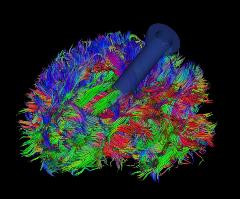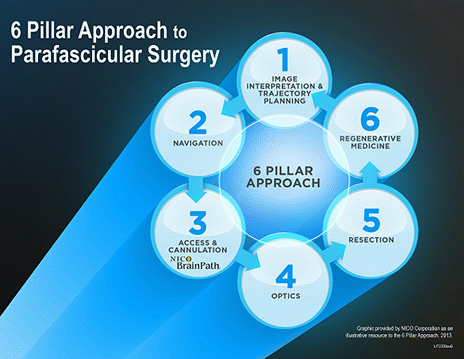Brain Path Technology
At Delray Medical Center, we are excited to be among the first hospitals in the country to offer the 6 Pillar Approach for patients with subcortical brain abnormalities such as tumors and hemorrhages. This new treatment integrates several existing
technologies and new advancements, allowing your doctor to see and ultimately remove abnormalities through an opening as small as a dime.

The 6 Pillars are:
- Brain Imaging
- Neuro-Navigation
- Access
- Optics
- Tissue Resection
- Regenerative Medicine
During the procedure, surgeons access your brain’s abnormality through a small opening. Then, with brain imaging, GPS navigation technology and a tool called the NICO BrainPath* they are safely able to move through the natural folds and millions
of delicate fibers in the brain to reach the abnormality. The BrainPath uniquely allows surgeons to displace tissues of the brain during advancement to the targeted abnormality. Once in place, the BrainPath creates a passageway for surgeons to access
the surgical field and then use a resection tool to remove the abnormality.

“Delray Medical Center is proud to lead the way in utilizing state-of-the-art medical technology in Florida,” said Chief Executive Officer Mark Bryan. “We are confident that the new equipment will have a positive influence on our patients
who suffer from neurological issues.”
Dr. Lloyd Zucker, Chief of Neurosurgery at Delray Medical Center, is currently one of the few neurosurgeons in Florida trained to use the 6 Pillar Approach and NICO BrainPath to remove anomalies such as malignant brain tumors and intracranial hemorrhages.
“It is a technology that expands our ability to operate safely on the brain and reach areas within the brain that we haven’t been able to safely reach before,” says Dr. Zucker.
Lloyd Zucker, MD, FAANS, Chief of Neurosurgery, is a member of the Subcortical Surgery Group.
The Subcortical Surgery Group (SSG) is a group of surgeons who believe in the mission of optimizing minimally invasive corridor surgery to the subcortical space through clinical and scientific collaborative research and technology applications. This transformational
and multidisciplinary strategy integrates the most advanced visualization and intervention technologies available to enable safe access to the tumor or stroke (ICH) while preserving essential tissue and structures. It opens new horizons for neurosurgeons
and patients and aims to make progress in surgical principles for the safe and effective treatment of patients with subcortical brain pathology. To find out more, visit https://www.subcorticalsurgery.com.